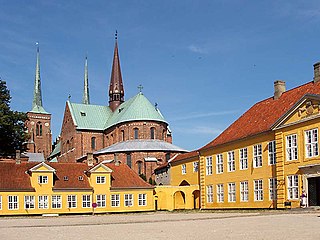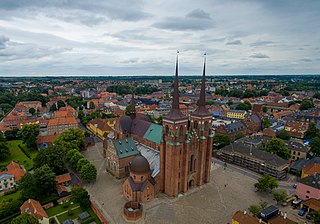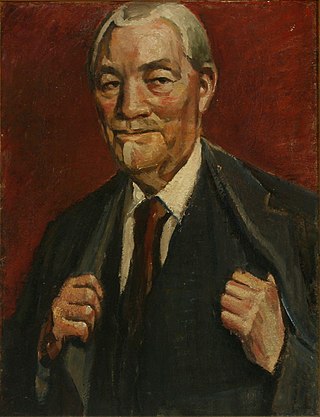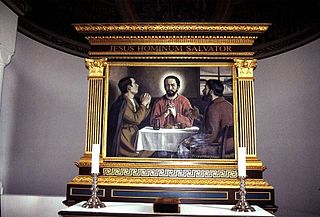
Roskilde is a city 30 km (19 mi) west of Copenhagen on the Danish island of Zealand. With a population of 52,974, the city is a business and educational centre for the region and the 10th largest city in Denmark. It is governed by the administrative council of Roskilde Municipality.

Peter Christian Thamsen Skovgaard was a Danish national romantic landscape painter. He is one of the main figures associated with the Golden Age of Danish Painting. He is especially known for his large scale portrayals of the Danish landscape.

Roskilde Cathedral, in the city of Roskilde on the island of Zealand (Sjælland) in eastern Denmark, is a cathedral of the Lutheran Church of Denmark.

Johan Christian Claussen Dahl, often known as J. C. Dahl or I. C. Dahl, was a Danish-Norwegian artist who is considered the first great romantic painter in Norway, the founder of the "golden age" of Norwegian painting. He is often described as "the father of Norwegian landscape painting" and is regarded as the first Norwegian painter to reach a level of artistic accomplishment comparable to that attained by the greatest European artists of his day. He was also the first to acquire genuine fame and cultural renown abroad. As one critic has put it, "J.C. Dahl occupies a central position in Norwegian artistic life of the first half of the 19th century.

Laurits Andersen Ring was one of the foremost Danish painters of the turn of the 20th century, who pioneered both symbolism and social realism in Denmark. Considered one of the masterpieces of Danish culture, his painting Summer Day by Roskilde Fjord was included in the 2006 Danish Culture Canon.
The Danish Golden Age covers a period of exceptional creative production in Denmark, especially during the first half of the 19th century. Although Copenhagen had suffered from fires, bombardment and national bankruptcy, the arts took on a new period of creativity catalysed by Romanticism from Germany. The period is probably most commonly associated with the Golden Age of Danish Painting from 1800 to around 1850 which encompasses the work of Christoffer Wilhelm Eckersberg and his students, including Wilhelm Bendz, Christen Købke, Martinus Rørbye, Constantin Hansen and Wilhelm Marstrand, as well as the sculpture of Bertel Thorvaldsen.

The National Gallery of Denmark is the Danish national gallery, located in the centre of Copenhagen.

Anna Maria Elisabeth Lisinska Jerichau-Baumann was a Polish-Danish painter. She was married to the sculptor Jens Adolf Jerichau.
Danish art is the visual arts produced in Denmark or by Danish artists. It goes back thousands of years with significant artifacts from the 2nd millennium BC, such as the Trundholm sun chariot. For many early periods, it is usually considered as part of the wider Nordic art of Scandinavia. Art from what is today Denmark forms part of the art of the Nordic Bronze Age, and then Norse and Viking art. Danish medieval painting is almost entirely known from church frescos such as those from the 16th-century artist known as the Elmelunde Master.

Ise Fjord is a deeply branched arm of the sea into the Danish island Zealand. From its relatively narrow entrance from the Kattegat at Hundested and Rørvig, branches of Ise Fjord stretch 35 km inland and divide the northern part of Zealand into the peninsulas of Odsherred, Hornsherred, and Nordsjælland.

Ved Vejen is a short novel written by the Danish author Herman Bang in 1886. It was originally published in Copenhagen by Det Schubotheske Forlag as part of a collection of four stories entitled Stille Eksistenser, centering on women who are subdued or living in isolation. It was first published independently in 1898. An impressionist novel, it relates the story of Katinka, a sensitive but ambitious young woman married to a boisterous and somewhat vulgar station master, Bai.

Church frescos or church wall paintings are to be found in some 600 churches across Denmark, no doubt representing the highest concentration of surviving church murals anywhere in the world. Most of them date back to the Middle Ages and were uncovered by Jacob Kornerup (1825–1913) who carried out restoration work in 80 churches across the country towards the end of the 19th century. They lay hidden for centuries as after the reformation, they were covered with limewash only to be revealed and restored during the course of the 19th and 20th centuries. In most of Europe medieval frescos, extremely common in the Middle Ages, were more likely to be removed completely during the Reformation or in subsequent rebuildings, or merely as they aged. The oldest frescos, dating back to the 12th century, were painted in the Romanesque style by artists from elsewhere in Europe but those from the 14th century and thereafter are in the Gothic style which was used by native Danish painters. It is these that are considered to be the most important for Danish art and culture. A distinction is to be made between these church wall paintings or kalkmalerier and the generic term "fresco" which refers to all types of painting on plastered walls or ceilings.

Christian Ferdinand Andreas Mølsted was a Danish artist who specialized in marine painting. He is best known for his painting of the frigate Niels Juel during the Battle of Heligoland on 9 May 1864.

Poul Simon Christiansen, frequently referred to as Poul S. Christiansen was a Danish painter who developed a Colourist style under Kristian Zahrtmann and as a result of his appreciation of the works of Paul Gauguin and Vincent van Gogh. He painted landscapes and religious works, many of which became popular as reproductions.

Randers Museum of Art is a Danish art museum in Randers in northeastern Jutland, Denmark. The museum is located in the cultural centre of Kulturhuset in the town centre and displays many of the major works of Danish painters, especially those of the 19th and 20th centuries.

Efterårsmorgen ved Sortedamssøen is an oil painting by Christen Købke, one of the leading artists in the Golden Age of Danish Painting. Included in the 2006 Danish Culture Canon, the painting hangs in Copenhagen's Ny Carlsberg Glyptotek.
Events from the year 2013 in Denmark.

Summer Evening at Skagen. The Artist's Wife and Dog by the Shore is an 1892 painting by P.S. Krøyer, one of the best known of the artistic community known as the Skagen Painters. The work shows Marie Krøyer, the artist's wife, standing on the beach at Skagen with their dog Rap at her side and the moonlight reflected in the sea.

Ole Laurits Olsen Søndergaard was a Danish landscape painter. He also decorated a number of Danish churches with paintings and frescos.
Ghita Johanne Hempel was a Danish painter.
















